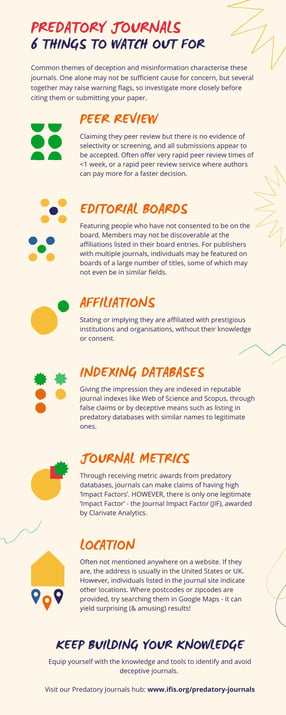Common characteristics
 There are some of the most common themes of deception and misinformation which characterise these journals. In isolation, any of these individual features may not be sufficient cause for concern, but several together may begin to raise warning flags for you and you should probably investigate more closely. Download the infographic >>
There are some of the most common themes of deception and misinformation which characterise these journals. In isolation, any of these individual features may not be sufficient cause for concern, but several together may begin to raise warning flags for you and you should probably investigate more closely. Download the infographic >>
Peer Review
Claims of a thorough peer review process are made, but there is no evidence that any peer review is carried out. There is no evidence of selectivity or screening based on editorial or quality checks as all submissions appear to be accepted.
As well as advertising peer review, these journals often offer very rapid peer review times of under a week, or rapid peer review service where additional payments can be made for a faster decision.

Editors / Editorial Boards
-
The editorial boards of deceptive journals often feature people who have not consented to be on the board.
-
The members may not be discoverable at the affiliations listed in their board entries.
-
For publishers with multiple journals, individuals may be featured on the boards of a large number of titles, some of which may not be in similar fields.
Affiliations
Similar to the co-opting of individuals, predatory journals may also state or imply they are affiliated with prestigious institutions and organisations, without their knowledge or consent.
Indexing Databases
Predatory journals often attempt to give the impression they are indexed in the key journal indexes Web of Science and Scopus, through outright false claims or by deceptive means.
In addition to predatory journals, there is a concurrent industry of predatory metrics, indexing databases, and conferences designed to capitalise on similar opportunities as the predatory journals.
Predatory databases share names very similar to the official mainstream sites such as Index Scientific Journals, which can use the acronym ISI to match the real ISI Web of Science. Therefore, a journal can claim to be listed in ISI, but refer to the pay-per-listing site, rather than the real site (which is free but has strict inclusion criteria).
These databases likely use Google Scholar to draw their citation metrics from – if they base them on anything at all. Their sources and methods are not usually explained or transparent. Inclusion in these databases is granted in exchange for a fee, with an ‘Impact Factor’ provided for an additional fee, so there is no barrier to inclusion other than a fee.
Some journals use these databases to list themselves and present as being indexed in prestigious, valuable scientific databases.
Other forms of deception and misdirection, or naivety, that these journals exhibit is by using databases inappropriately. For example, presenting sites such as ResearchGate and Mendeley as indexing databases, or claiming Thomson Reuter Researcher IDs, Scopus Researcher IDs and ORCiD accounts in the name of a journal.
Journal Metrics
The deceptive practices around metrics follow a similar theme to index databases. Through receiving metric awards from predatory databases, journals can make claims of having high ‘Impact Factors’.
It is important to note that there is only one legitimate ‘Impact Factor’ - the Journal Impact Factor (JIF), awarded to journals indexed in the Web of Science, owned by Clarivate Analytics. Find out more about legitimate journal metrics and databases.
Deceptive journals may also have very high self-citation rates to inflate their Google Scholar citation metrics. There are also journals indexed in Scopus and Web of Science that succeed in being indexed with relatively low citation counts, then display large increases in citations, all powered through self-citations. These are visible in the Scopus SJR database.
Location
The locations or offices of deceptive journals or publishers are quite often not mentioned anywhere on a website. If they are mentioned, the address is usually in the United States, or UK. However, the Editorial Boards and author locations of the individuals listed in the journal site indicate other locations.
In some cases, where postcodes/zipcodes are provided, these can be put into Google maps and searched and can yield surprising or amusing results.









